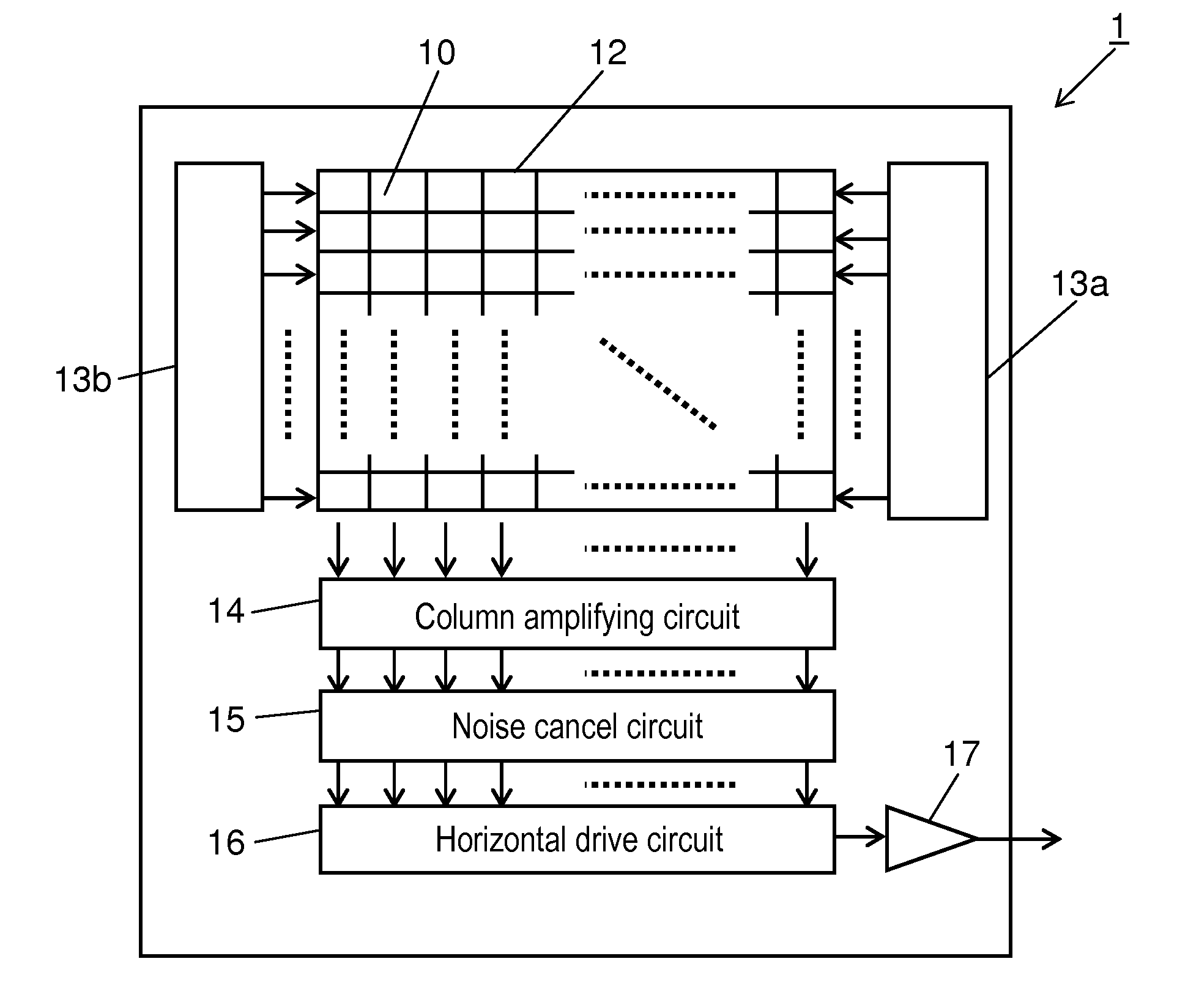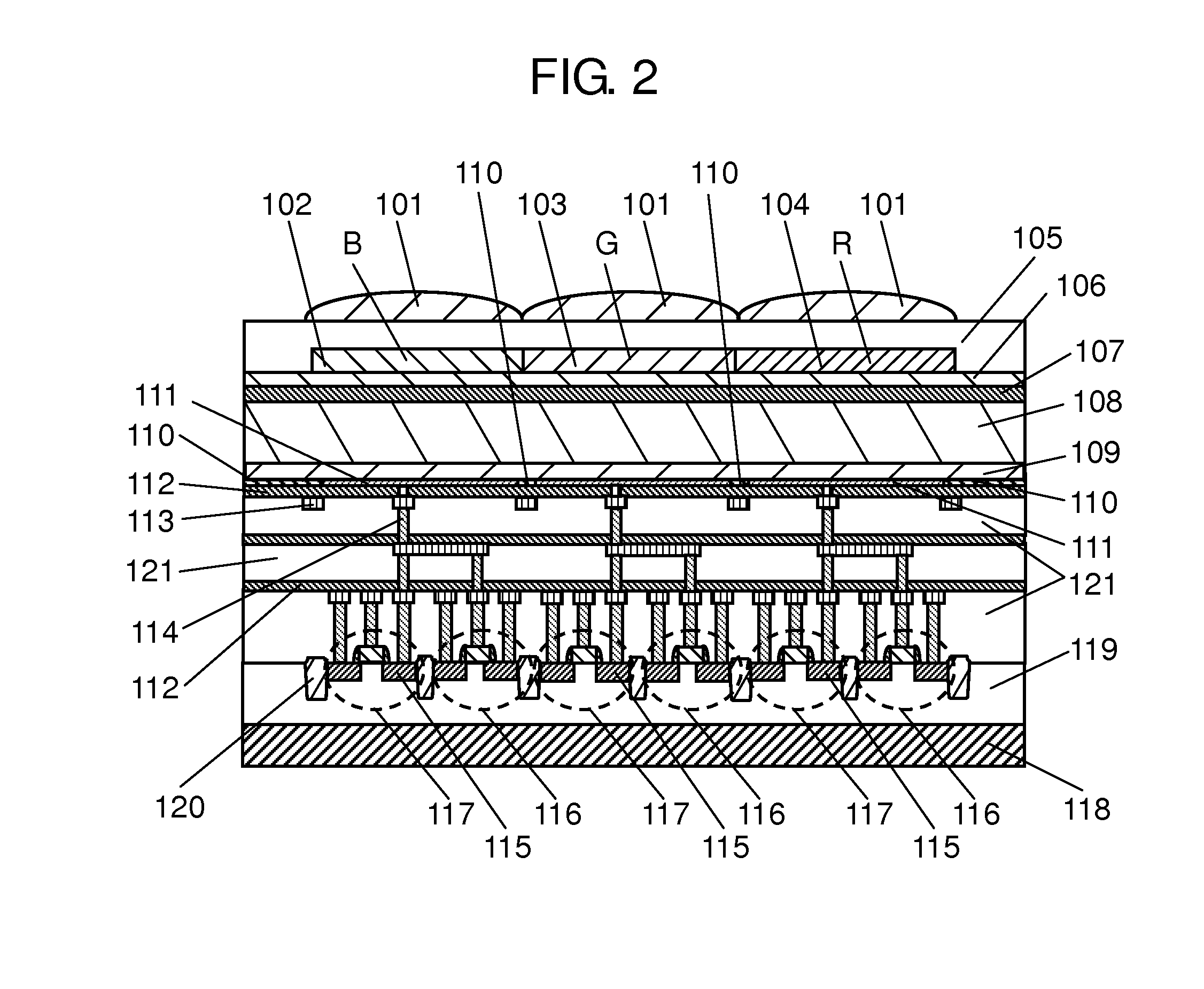Solid-state imaging apparatus
a solid-state imaging and apparatus technology, applied in the field of solid-state imaging apparatus, can solve the problems of deteriorating noise suppression effect, difficult to obtain sufficient gain in fine pixel, etc., and achieve the effect of reducing ktc nois
- Summary
- Abstract
- Description
- Claims
- Application Information
AI Technical Summary
Benefits of technology
Problems solved by technology
Method used
Image
Examples
first exemplary embodiment
[0028]An overall configuration of a solid-state imaging apparatus according to a first exemplary embodiment will be described.
[0029]FIG. 1 is a block diagram illustrating an overall configuration of the solid-state imaging apparatus according to the first exemplary embodiment. Solid-state imaging apparatus 1 illustrated in FIG. 1 includes pixel unit 12 having a plurality of pixels 10 arranged in a matrix on a semiconductor substrate, row signal drive circuits 13a and 13b, column amplifying circuit 14 arranged for each column, noise cancel circuit 15, such as a correlated double sampling (CDS) circuit, arranged for each column, horizontal drive circuit 16, and output stage amplifier 17.
[0030]FIG. 2 is a sectional view illustrating the structure of the solid-state imaging apparatus according to the first exemplary embodiment for three pixels. In an actual solid-state imaging apparatus, ten million pixels, for example, are arranged in the pixel unit 12 in a matrix. As illustrated in FI...
second exemplary embodiment
[0067]FIG. 5 is a diagram illustrating one example of a circuit of pixel 10 belonging to an mth row (m is a natural number) and an nth column (n is a natural number) of pixel unit 12, and its control circuit according to a second exemplary embodiment.
[0068]The different point from the circuit structure according to the first exemplary embodiment is such that amplifying transistor 116 is connected to cutoff transistor 302 via selection transistor 501. Specifically, one of a source and a drain of selection transistor 501 is connected to the other one of the source and the drain of amplifying transistor 116. The other one of the source and the drain of selection transistor 501 is connected to one of the source and the drain of cutoff transistor 302. The other one of the source and the drain of selection transistor 501 is connected to other one 303 of the source and the drain of reset transistor 117.
[0069]FIG. 6 is a timing chart illustrating a driving method for pixels on the mth row i...
third exemplary embodiment
[0084]Next, a third exemplary embodiment will be described.
[0085]FIG. 7 is a diagram illustrating one example of a circuit of pixel 10 belonging to an mth row (m is a natural number) and an nth column (n is a natural number) of pixel unit 12, and its control circuit according to a third exemplary embodiment.
[0086]The pixel unit 12 includes, for each column, a column signal line 702 which is connected to a reference potential or outputs a pixel signal from the pixel 10, and a source line 701 connected to third power supply voltage VDD3. One of the source and the drain of amplifying transistor 116 is connected to column signal line 702. The other one of the source and the drain of cutoff transistor 302 is connected to source line 701. One end of column signal line 702 is connected to a signal output unit (terminal E) or a reference potential (terminal F) via terminal TE3. Source line 701 and column signal line 702 provided for each column are commonly connected to a plurality of pixel...
PUM
 Login to View More
Login to View More Abstract
Description
Claims
Application Information
 Login to View More
Login to View More - R&D
- Intellectual Property
- Life Sciences
- Materials
- Tech Scout
- Unparalleled Data Quality
- Higher Quality Content
- 60% Fewer Hallucinations
Browse by: Latest US Patents, China's latest patents, Technical Efficacy Thesaurus, Application Domain, Technology Topic, Popular Technical Reports.
© 2025 PatSnap. All rights reserved.Legal|Privacy policy|Modern Slavery Act Transparency Statement|Sitemap|About US| Contact US: help@patsnap.com



